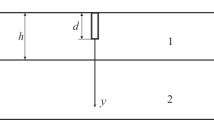Abstract
The effect of friction on the critical temperature of ignition is considered by establishing the friction ignition model based on the principle of the heterogeneous reaction of Semenov. The effects of the oxygen concentration, flow velocity, friction force, and contact area on the critical temperatures of two fireproof titanium alloys (TB12 and TF550) are studied. The results show that the critical temperature decreases with an increase in the oxygen concentration and increases with the flow velocity. The critical temperature increases approximately linearly with an increase in the friction force and decreases exponentially with an increase in the contact radius. As the contact radius increases to 0.007 m, the critical temperatures of TF550 and TB12 are 1029 and 1016 K, respectively. As the contact radius reaches 0.014 m, the critical temperatures of TF550 and TB12 are 962 and 960 K, respectively.





Similar content being viewed by others
REFERENCES
V. G. Anderson and B. A. Manty, “Titanium Alloy Ignition and Combustion," Report No. 76083-30 (Naval Air Development Center, 1978), pp. 10–32.
G. B. Mi, X. Huang, J. X. Cao, et al., “Frictional Ignition of Ti40 Fireproof Titanium Alloys for Aero-Engine in Oxygen-Containing Media," Trans. Nonfer. Met. Soc. China 23 (8), 2270–2275 (2013).
F. E. Littman, F. M. Church, and E. M. Kinderman, “A Study of Metal Ignitions I. The Spontaneous Ignition of Titanium," J. Less-Common Met. 3 (5), 367–378 (1961).
E. A. Borisova and K. V. Bardanov, “Ignition of Titanium Alloys in Media Containing Oxygen," Met. Sci. Heat. Treat. 5(2), 98–101 (1963).
B. I. Khaikin, V. N. Bloshenko, and A. G. Merzhanov, “On the Ignition of Metal Particles," Fiz. Goreniya Vzryva 6(4), 474–488 (1970) [Combust., Expl., Shock Waves 6 (4), 412–422 (1970)].
V. G. Abramov, V. T. Gontkovskaya, and A. G. Merzhanov, “Theory of Thermal Combustion. Communication 1. Principles of the Transition from Autoignition to Ignition," Izv. Akad. Nauk SSSR, Ser. Khim., No. 3, 429–437 (1966) [Russ. Chem. Bull. 15 (3), 404–410 (1966)].
A. B. Arutyunyan, S. L. Kharatyan, and A. G. Merzhanov, “Theory of Metal Particle Ignition. I. Ignition of Metal Particles in the Formation of Solid Solutions," Fiz. Goreniya Vzryva15 (3), 16–22 (1979) [Combust., Expl., Shock Waves15 (3), 299–304 (1979)].
A. G. Merzhanov, “Thermal Theory of Metal Particle Ignition," AIAA J. 13 (2), 209–214 (1975).
A. P. Aldushin, V. N. Bloshenko, and B. S. Seplyarskii, “Ignition of Metal Particles with a Logarithmic Oxidation Law," Fiz. Goreniya Vzryva 9 (4), 489–496 (1973) [Combust., Expl., Shock Waves 9 (4), 423–428 (1973)].
A. P. Aldushin and B. I. Khaikin, “Combustion of Mixtures Forming Condensed Reaction Products," Fiz. Goreniya Vzryva10 (3), 313–323 (1974) [Combust., Expl., Shock Waves10 (3), 273–280 (1974)].
E. V. Chernenko, V. A. Griva, and V. I. Rosenband, “Investigation of the Laws of Ignition of Titanium Powders," Fiz. Goreniya Vzryva 18 (5), 20–26 (1982) [Combust., Expl., Shock Waves18 (5), 20–26 (1982)].
U. R. Evans, “The Mechanism of Oxidation and Tarnishing," Trans. ES 91 (1), 547 (1947).
V. I. Bolobov, “Possible Mechanism of Autoignition of Titanium Alloys in Oxygen," Fiz. Goreniya Vzryva 39 (6), 77–81 (2003) [Combust., Expl., Shock Waves 39 (6), 677–680 (2003)].
V. I. Bolobov, “Theory of Ignition of Metals at Fracture," Fiz. Goreniya Vzryva 48 (6), 35–40 (2012) [Combust., Expl., Shock Waves 48 (6), 689–693 (2012)].
V. I. Bolobov, “Effect of Heat Transfer Conditions on the Critical Pressure of Metal Ignition in Oxygen," Fiz. Goreniya Vzryva52 (2), 54–59 (2016) [Combust., Expl., Shock Waves52 (2), 172–176 (2016)].
G. B. Mi, X. Huang, J. X. Cao, et al., “Ignition Resistance Performance and its Theoretical Analysis of Ti–V–Cr Type Fireproof Titanium Alloys," Acta Metall. Sin. 50 (5), 575–586 (2014).
G. B. Mi, X. Huang, J. X. Cao, et al., “Microstructure Characteristics of Burning Products of Ti–V–Cr Fireproof Titanium Alloy by Frictional Ignition," Acta Phys. Sin. 65(5), 056103 (2016).
G. B. Mi, C. X. Cao, X. Huang, et al., “Non-Isothermal Oxidation Characteristic and Fireproof Property Prediction of Ti–V–Cr Type Fireproof Titanium Alloy," J. Mater. Eng. 44 (1), 1–10 (2016).
X. Y. Liang, G. B. Mi, L. J. He, et al., “Numerical Simulation of Combustion Resistant Titanium Alloy Wear Behavior at High Temperature Fields," Mater. Sci. Forum 913, 168–175 (2018).
M. R. Glickstein et al., “Ignition and Self-Sustained Combustion of Titanium Alloys," in Third DOD Conf. on Laser Effects, Vulnerability and Countermeasures, July 19–22, 1977 (Naval Train. Center, 1977), pp. 19–22.
Author information
Authors and Affiliations
Corresponding author
Rights and permissions
About this article
Cite this article
Liang, XY., Mi, GB., Li, PJ. et al. Mathematical Model of Critical Condition for Friction Ignition. Combust Explos Shock Waves 56, 585–591 (2020). https://doi.org/10.1134/S001050822005010X
Received:
Published:
Issue Date:
DOI: https://doi.org/10.1134/S001050822005010X




